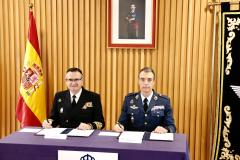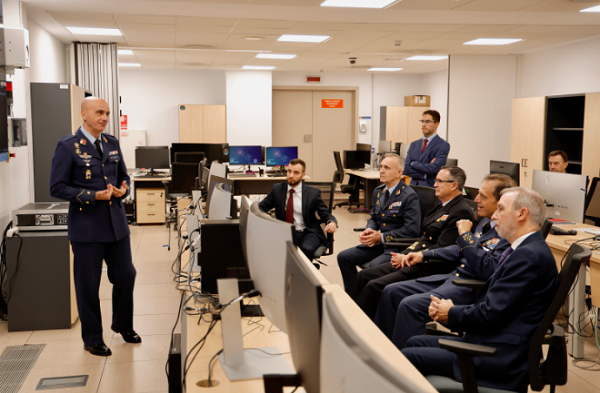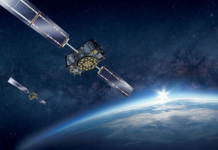Highlights:
- The Spanish Air and Space Force and Spanish Directorate General of Weapons and Material have formally accepted delivery of the CCSE system developed by GMV, which will be used to strengthen the country’s space surveillance and control operations
- The new system is being integrated into the Space Operations and Surveillance Center (COVE), and it will expand the country’s capabilities related to space security and situational awareness
Today at its headquarters at the Torrejón Air Base near Madrid, the Spanish Space Command performed the official acceptance event for a Space Situational Awareness and Control System (CCSE). This is a key tool for surveillance, control, and management of activities in the space environment, developed by the multinational technology firm GMV for the Spanish Ministry of Defense.
The ceremony presided over by the Chief of Staff of the Spanish Air and Space Force (JEMA), General Francisco Braco Carbó, included the signing of the official system acceptance protocol by Admiral Aniceto Rosique Nieto, Director General of Armament and Material (DiGAM), and Major General Isaac Manuel Crespo Zaragoza, Commander of the Space Command.

During the event, Admiral Aniceto Rosique Nieto, DiGAM, emphasized the strategic role of Spain’s technology industry in the fields of defense and space sovereignty: “The space sector holds critical importance in an increasingly complex and interconnected world, where the relentless advance of disruptive technologies, along with hybrid, energy, and environmental threats, poses historic challenges.” He also highlighted that “the CCSE system is technologically cutting-edge in Europe, at a level reached by very few countries.”
The CEO of GMV was also present, Jesús B. Serrano, and during his remarks he stressed the importance of this project for strengthening Spain’s space capabilities: “with this CCSE system, GMV is making cutting-edge space technology available to the Spanish Ministry of Defense. The system represents the result of our leadership, experience in the industry, and ongoing investment in R&D. These are dual-use technologies that will not only enhance Spain’s space surveillance and security capabilities, but also advance the country’s technological development in general.”

Afterwards, those in attendance were able to observe an operational demonstration of the new CCSE system at the Space Operations and Surveillance Center (COVE), where its ability to present a comprehensive view of the space situation and ensure the safety and security of the country’s space assets was evident.
A key system for space sovereignty
The CCSE system was created in 2019 as part of the evolution of the Space Operations and Surveillance Center (COVE) under the Spanish Space Command (MESPA), with the aim of serving the national interest by ensuring security and situational awareness for the space environment. Its Initial Operational Capability (IOC) was demonstrated in 2021, and since then, COVE has participated in international exercises such as Global Sentinel, organized by the United States Space Command with GMV’s technological support.
Among the system’s main features are orbital calculation and propagation, the generation and maintenance of a space object catalog, atmospheric reentry prediction, observation campaign planning, overflight computation, GNSS signal degradation analysis, and space weather data processing. The system also stands out for its ability to process data from space surveillance sensors, such as the Spanish S3TSR radar located at Morón Air Base (Seville).
The software for the CCSE system is based on Ecosstm. This is a commercial off-the-shelf (COTS) solution developed by GMV, which is already in use in other military and civilian operational systems.
Institutional participants
In addition to Air Force General Francisco Braco Carbó and Divisional General Isaac Manuel Crespo Zaragoza, head of the Space Command (MESPA), the event was also attended by other high-ranking Air and Space Force officers including Divisional General Alfonso María Reyes Leis, head of the Torrejón Air Base (who also participated in the initial acceptance event), and Brigadier General Enrique Cuenca-Romero Jiménez, head of the Cabinet for the Air and Space Force Chief of Staff (JEMA).
The Spanish Ministry of Defense and its Directorate General of Weapons and Material (DGAM) was represented by Admiral (R) Aniceto Rosique Nieto, Director General of Weapons and Material; Lieutenant General José Antonio Gutiérrez Sevilla, Deputy Director General of Programs for the DGAM; Colonel Manuel María Jiménez Rodríguez, Head of the CCSE Program Office at the Sub-Directorate General of Programs for the DGAM; and Fernando Arias Miguélez, Dennis Belén Estévez Albuja, and Abel Cuchi Olcina, who are all members of the Technical Assistance Team at that same CCSE Program Office.
Other representatives of the Air and Space Force connected with the Space Operations and Surveillance Center (COVE) were also present, including Colonel Javier Martínez Rodríguez, head of the Cooperation and Representation Section (S9) of the Space Command; Colonel Óscar Calzas del Pino, head of the Command and Control, Space Systems, and Cyberspace Planning Section (Spanish Navy Plans Division); Lieutenant Colonel José Antonio Fernández Ferrándiz, head of the Plans Section (S5) of the Space Command; Lieutenant Colonel Manuel Olmos Holgado, head of the Space Operations and Surveillance Center (COVE); and the Warrant Officer of the Space Command, Alejandro Rodríguez Merino.
Representing GMV were Jesús B. Serrano, CEO of GMV; Miguel Ángel Molina, Deputy General Manager of Space Systems EST at GMV; Manuel Pérez, Director of Defense and Security; as well as Diego Escobar Antón, Ángel Gallego Torrego, Jesús Tirado Vélez, and David Moreno Espinosa, representing the entire GMV team responsible for the system’s development.


















